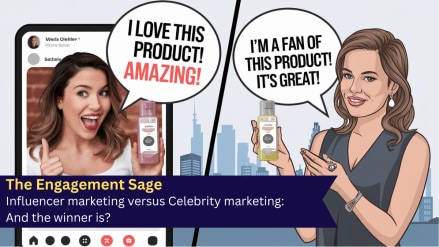There was a time when a brand would rope in a popular actor, singer, or athlete dubbed as a celebrity to promote the product. Remember the ever-popular Pepsi ad featuring Michael Jackson in the ’80s? Just to give a background, in November 1983, one year after his album Thriller was released, Michael Jackson (and his brothers) struck a $5 million (£3.1 million) deal with Pepsi to become the first pop stars to front campaigns for the brand. Back at home, one can easily remember Aamir Khan and the Coke ad, with the tagline, “Thanda matlab Coca-Cola” to actor Shah Rukh Khan being one the few male actors to promote the beauty soap brand Lux. But that was then, in today’s world, celebrities have strong competition with influencers. From Kusha Kapila to Nancy Tyagi, Ankush Bahuguna, among others are some names brands are cashing in on to create a buzz.
What is celebrity advertising?
Also known as celebrity endorsements, this format of marketing strategy includes brands using celebrities in this case the person need not be just an actor, but also a singer, athlete, sportsman or sportswoman, in other words, the definition of celebrity at one point in time was a popular figure among consumers, so politicians at times have also been roped in to promote brands or products. Marketers rope in these celebrities to leverage their fame and create a short-term brand recall.
Besides brands not-for-profit organisations leverage a celebrity’s fame to raise awareness or funding around a cause. Typically two very basic criteria determine how a celebrity is chosen – does the celebrity represent brand value and how large is the fan base?
What is influencer marketing?
Here comes the new breed of celebrity called influencers. These have gained popularity thanks to social media. From YouTube to Instagram – these content creators started their journey either through comedy or by creating beauty tutorials and even for that matter sowing dresses. What sets them apart from regular celebrities is that content has remained a constant aspect of their growth. It is through their content that they drive engagement, which seems more real when compared with a celebrity. This is also a reason why some of the more successful influencers have a high number of followers on their social media channels and drive high engagement. Brands rope in these influencers to not only drive product tests and tutorials but also to promote products from time to time.
Earnings!
The cumulative number of product brand endorsements by the top 20 celebrities increased
to 484 in 2023, reflecting an increase of 14.2% from 424 product brands in 2022. This growth can be attributed to the increase in the number of TV and digital endorsements which grew by about seven percent and five percent, respectively. Further, this represents a CAGR
of 6.9% over the last five years growing from 370 product brands in 2019, as per a recent KROLL report.
The report further stated that in the first and the more popular model, a celebrity will be contracted for a specified term (usually one or two years) for a fixed-fee payment that may be
made through an initial signing amount with the balance to be paid upon completion of specified activities. These agreements may also involve a royalty component. These celebrities are called “brand ambassadors” owing to their long-term association with the endorsed product.
The second and less popular form of engagement is a one-time appearance by a celebrity for a specified event, as per the report. This may be in the form of a single photo or video advertisement shoot or a single post on a social media platform or attendance at an event. Apart from the regular fee payments, celebrity endorsement contracts may also include an ‘in-kind’ payment. The product being endorsed is supplied to the celebrity for free for a specific term. This is particularly prominent in the case of high-end luxury brands, the report stated.
Coming back to influencers as per a recent McKinsey report, an influencer is paid a flat rate per post to feature a product or service. This is known as a brand deal. The study further revealed that flat rates can be anywhere between three to five figures, even for an influencer without millions of followers or a global profile. As per the McKinsey report, an influencer posts about a product or service, with a link to a purchase gateway. Every time a viewer buys the product by clicking through the link or using a promo code, the influencer earns an affiliate commission.
Swimsuit model and influencer Alexa Collins, who has about three million followers on Instagram, in 2020 told Insider that she charged at least $1,000 for a sponsored story on her Instagram account.
The rate card is based on the reach of each influencer. For instance, nano influencers are the once who have fewer than 10,000 followers, while micro influencers have from 10,000 to 50,000. Meanwhile, medium influencers have from 50,000 to 100,000 followers and macro influencers have more than 500,000. Lastly, mega influencers have over one million followers.
To be sure, celebrities no longer have the field to themselves and will have to learn to live with their bitter halves. However, will there a day come that influencers will charge more than celebrities, only time will tell.
